
Last week, People for Bikes, the largest and most influential bicycle advocacy organization in America, named Naito Parkway as one of the best new bike lanes in the country. I don’t usually pay attention to “best of” lists, but something about that recognition felt different. And it felt like something that deserved more attention than a quick churn of the news cycle.
The protected bike lanes on Naito Parkway — which opened in May 2022 and are known affectionately as “Better Naito” — aren’t just among the best bike lanes in the city from an engineering perspective, they also represent the best of Portland more broadly in ways that transcend a typical infrastructure project.
In the past week or so I’ve been wondering: What makes Better Naito so great?
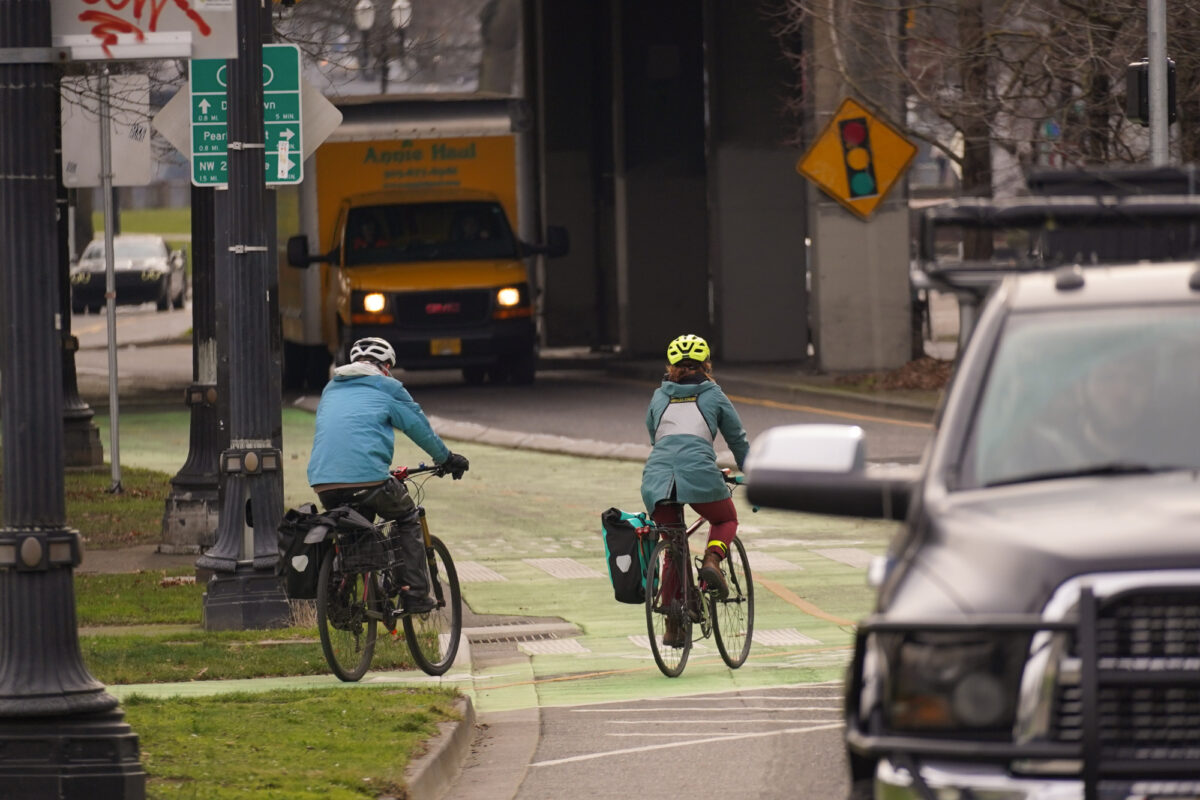
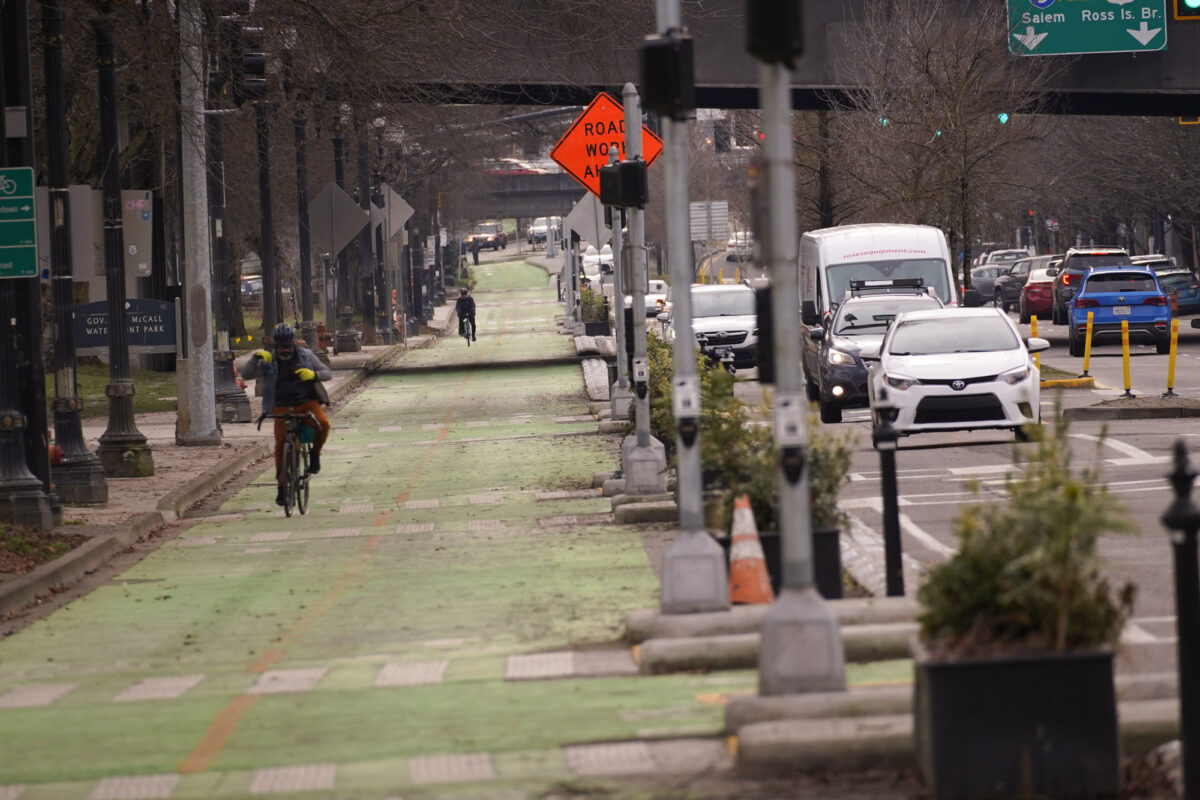
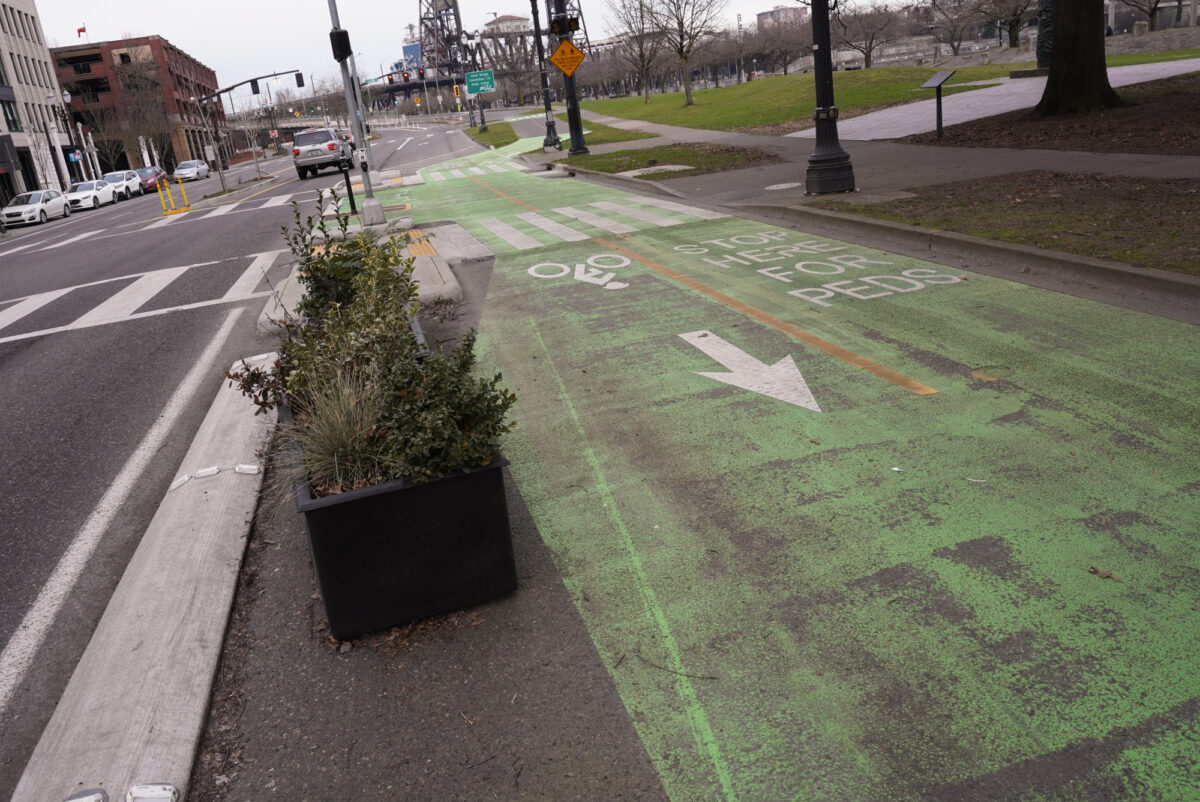

From an engineering perspective
To refresh, Better Naito is a two-way protected bikeway on the east side of Naito Parkway, a major street that runs along Portland’s waterfront. The project replaced a stressful and dangerous, 1990s paint-only bike lane.
Protection: I know some folks wanted even more width for the bikeway, but it’s relatively wide and offers a solid sense of protection from car and truck users. The width of the biking space is 14-feet curb-to-curb (at minimum, some sections are wider), and when combined with the concrete curb and other traffic separators, it feels plenty wide and comfortable for most riders. On the flipside, drivers have much less room to operate, and their behavior reflects that. In my experience, drivers have slowed way down and are pretty chill as they navigate next to the bikeway. The design is also strong enough to communicate to drivers that they aren’t allowed in the space.
Length, location and connections: At about 1.2 miles long, the bikeway runs from just south of the Steel Bridge to SW Lincoln. This length means it connects to many other bikeways. Better Naito makes it easy to hop onto SW Oak, NW Couch, the Hawthorne Bridge, or the cool little shortcut to SW Main we highlighted yesterday. The value of Better Naito also goes up because of where it is. Portland’s first real separated bikeway was built on NE Cully Blvd in 2011. It’s nice, but it was put there because of bureaucratic serendipity (PBOT did a full road rebuild and had a clean slate to work with) and not because there was a lot of cycling demand or other bike network connections in the area. Like too much of PBOT’s best work, it was an inaccessible oasis. Naito on the other hand is in a well-connected, high-demand, and high-profile location on one of Portland’s marquee streets (recall that the Portland Business Alliance opposed the project).
Signals: An unsung hero of Better Naito (and many other bikeways citywide) are smart, bike-friendly signals installed by PBOT. The signals are programmed to detect the presence of bicycle riders and they show a level of respect and seriousness that takes the Naito bike lanes from good to great.
For walkers too: Better Naito also came with a new, 8-foot sidewalk to give walkers a space of their own. There are also several signalized crossings with large median refuge islands where walkers can safely wait to cross.
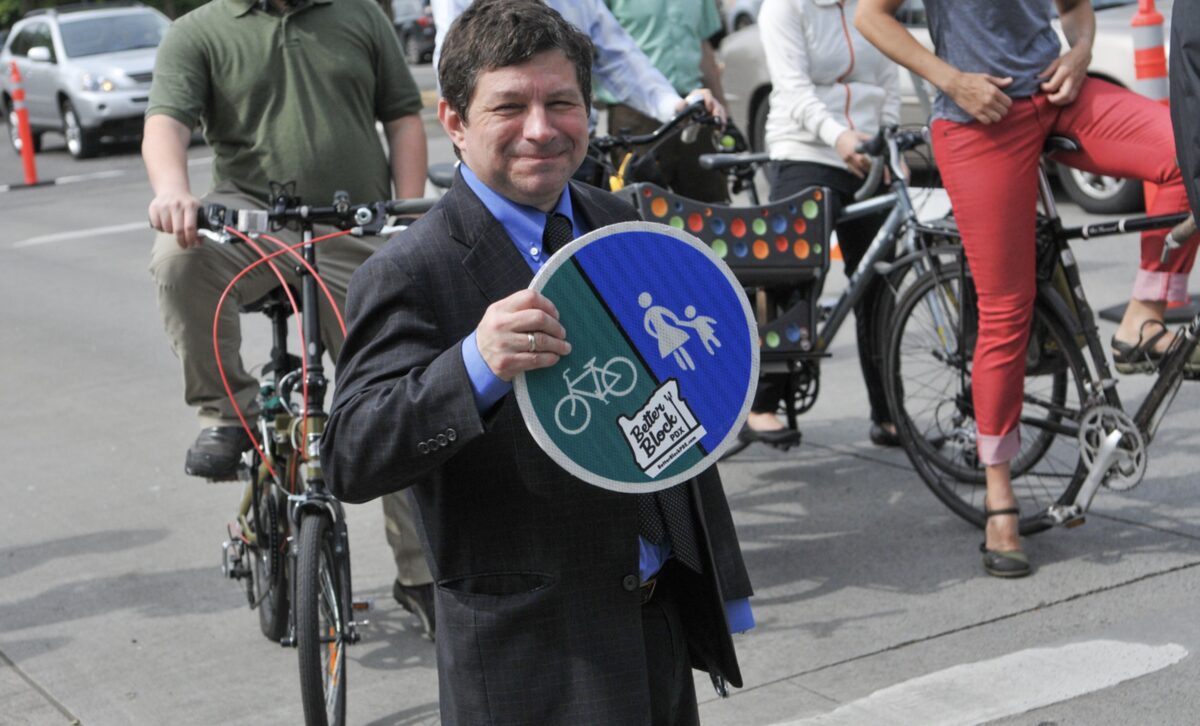

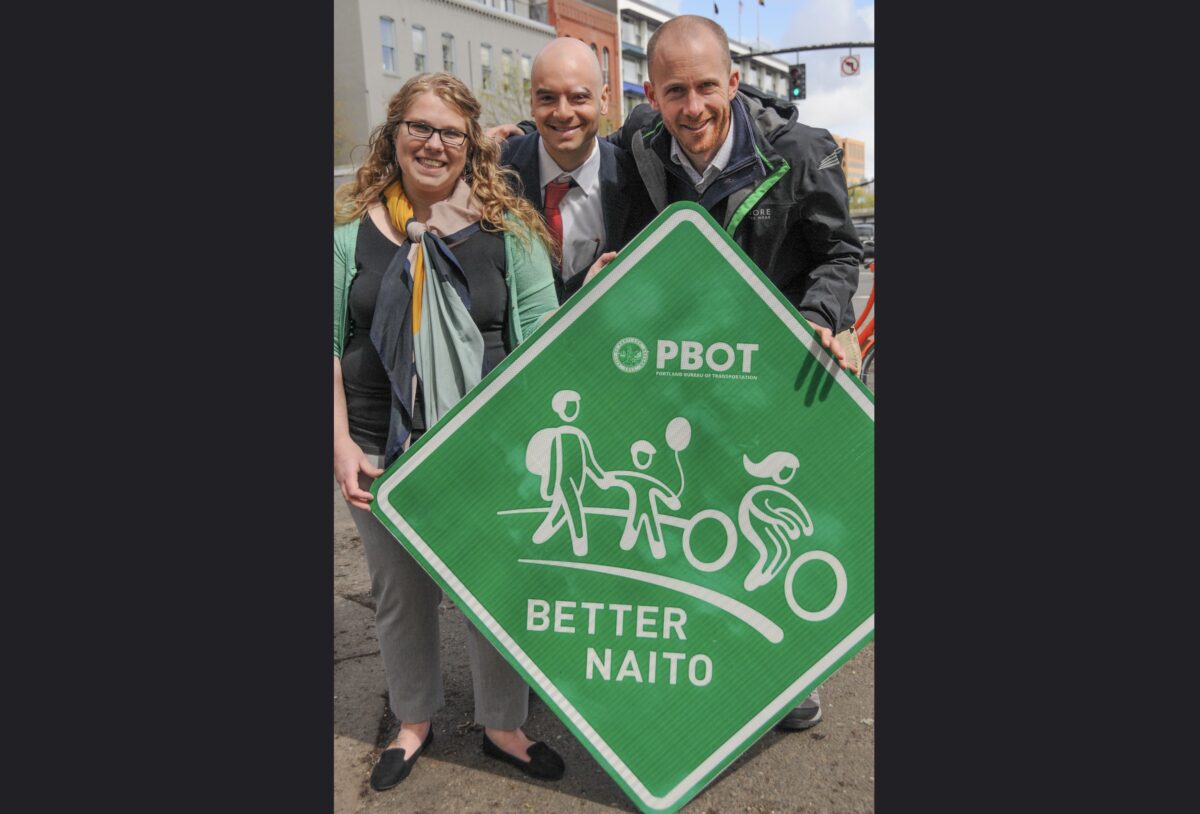
From a cultural perspective
The origin story of Better Naito matters almost as much as its ultimate success.
In the words of Timur Ender, a former PBOT staffer and volunteer activist with Better Block PDX who helped bring it to life, “Better Naito is a success story on a number of fronts: it’s a success story of accessible government, tactical urbanism as a way of urban planning, partnerships, data, and imagination.” In a BikePortland comment Ender shared after the ribbon was cut last spring, he shared that the idea for Better Naito wasn’t even on PBOT’s radar until 2015. That’s when the festival season on Waterfront Park began and we helped document the urgent need for more space for walkers and bikers during these events. PBOT responded with a creative permit to handle the event loading zone that led to a de facto, 24-hour lane open only for loading, walking, and biking during the two-week Rose Festival.
PBOT’s partnership with festival organizers and nonprofit tactical urbanism group Better Block PDX led to the most ambitious and consequential transportation pilot project the city has ever seen. “This was very much a leap of faith and there were a number of things we didn’t know until we did it,” is how Ender described the early days of the project. “Better Naito was also a success in bridging the connection between grassroots tactical urbanism and the halls of power in city government.”
In the end, the magic sauce of dedicated activists and city staffers willing to compromise and work together, led to something very special: A $15,000 pilot project done with traffic cones and plywood that led to over $15 million in infrastructure and several awards for the people for the people who made it happen.
But don’t take my word for it! Here’s what a few Portlanders think about it…
Andy Kutansky, a transportation engineer who works and rides in Portland:
“As a bike rider it is satisfying to see a super low-stress, two-way bike facility come to life. We don’t always say it explicitly, but what makes these facilities great is the ability to interact with our community; we can take both lanes and ride three abreast or interact with the riders going the opposite direction. I love how all the green paint on the cover image makes the facility really stand out, and its clear even from several hundred feet up that separated, all ages and abilities facilities are what the people want, and are here to stay.
From an engineering perspective I’d like to shine a light on the impact these types of projects can have for the price. This project, designed and constructed for under $4 million, can be a blueprint for thousands of other communities who want to reallocate public space for all users. All it takes is a little determination.”
Chris Thomas:
The lack of cross traffic makes it a much more enjoyable ride. No threat of a car running a stop sign/light and cutting you off.
Brendan Tschuy:
Better Naito gives a chance to relax and unwind on rides to work every morning. Few places in Portland provide that.




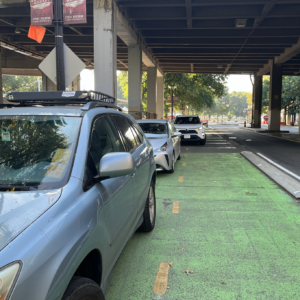
Thanks for reading.
BikePortland has served this community with independent community journalism since 2005. We rely on subscriptions from readers like you to survive. Your financial support is vital in keeping this valuable resource alive and well.
Please subscribe today to strengthen and expand our work.
It’s really sad to see all of the advocacy and hard work, and all that money and concrete used for nothing more than casting the ideas of 2015 in stone. They could have simply condensed the car traffic into a two-way street with stop signs on the west side of the existing median and been done. What we got instead is too narrow for purpose, already compromised for festival uses and vendor parking at the market. The extra space they saved for cars at great expense and delay just creates car traffic and congestion, #InducedDemand.
TBH I haven’t found much use for it and prefer to ride surface streets.
It’s nice but still segregated from anywhere you actually need to be downtown. Turning left is awkward and waiting for light cycles invites cyclists (and peds) to ignore safety devices.
I know it’s the current recipient of some congratulatory ballyhoo but… is this really the game-changer the activists thought it was?
Doesn’t help that downtown is still a ghost of its former self.
Yeah, it is a huge game changer. As someone who’s ridden every iteration of it for the past couple of decades, there’s no substitute for a fear-free ride from NW to the Hawthorne and the other paths south, it’s 1000% better than what we had a few short years ago. Yes, making a left into town is a bit inconvenient but- I’ll take the safety of that lane any day I can. Also note, the connections are beginning to appear.
I love that when I ride on it, I rarely see anyone else using it, so I have the place to myself. It feels very luxurious!
I love better Naito, I go several blocks out of my way to use it. A big emphasis on why it is so great is just how much faster it is to use this. It is straight, direct, and unimpeded, a true bicycle highway.
I just wish that better Naito continued further north and south. Coming from SW riding down Barbur, it is a pretty awkward connection to get to Naito. Continuing north, it just ends after Broadway bridge into a regular bike lane, yet there is more than enough right-of-way if they just removed the parking.
‘Just remove the parking’ should be our mantra. Even parked cars have priority over the safety of bikes and walkers.
What makes Better Naito so great is that it runs alongside a park with no cross streets. As soon as there is cross traffic, separated infrastructure starts making less and less sense and becomes more and more dangerous to use. I will never, ever ride in the separated facility on lower Hawthorne for this reason.
I’ve ridden on Hawthorne from work for the last 4 years and I can count on one hand the number of times I’ve had conflicts with drivers and not all of them were after the separated lane was put in. Very few drivers are looking to make a right from Hawthorne except at the lights so that’s not much of a problem. The biggest issues are still the same as they were before drivers trying to dart across Hawthorne from 6th and drivers turning right onto 11th and into Ladds addition. The no right on red signs don’t seem to get noticed.
Honestly, the erratic light timing and not being able to pass slower riders in the protected lane are more of a headache than drivers. Those issues occur weekly.
I use it, but mostly only when I would use the entire thing – which for me would typically be connecting between the Hawthorne bridge and somewhere in the Pearl or NW. It’s a bit clunky to get on/off outside the terminal entrances. I think it’s a pretty good project though, and is my preferred N/S route in the downtown area by a lot (although I’ll take Broadway going SB occasionally as well)
I saw that same best of list, and thought it odd they only mentioned the government agency and not all of the citizens’ work that went into that. Heck I even used to pick up the crushed wands during the early years, and once I landed head on with traffic when a two-block segment had been removed by an unloading crew and not replaced. Oh and that time I went head to head with a driver errantly in the bike lane (I have video of that one). They just kept waving me out of their way. Nice to have it finally finished.
Better Naito is a great idea, but poorly executed. This is a complete street rebuild, yet PBOT closed a crosswalk- at a hotel (at Morrison)! They also failed to grade it correctly- there are numerous puddles/standing water and sharp bumps at unnecessary concrete asphalt transitions across Naito. They also failed to make a safe connection to the Steel bridge- the geometry is terrible, the south side visibility is blocked by blackberries, and 8(!) streetlight lampheads have been non-functional since September- the light levels are dangerously low within the interchange of the Steel Bridge. The most laughable mistake is on the ramp from the south side of the Hawthorne Bridge- they have signed about 4.5 feet as 2-way bike traffic, and the remaining 4-4.5 feet as pedestrian only- why invest in all that thermoplastic for a an impossible scenario. I ride this nearly every day on my commute at various times of the day and night in all weather. I agree that it has a lot of potential, but it is very frustrating to see PBOT fall short due only to incompetence and care – it would not have cost any more or taken longer to build this correctly. I think the activists and the politicians get the credit for this- they forced PBOT to do it. PBOT revealed their anti-bike and pedestrian bias by letting this get built so poorly.
“PBOT revealed their anti-bike and pedestrian bias”
I know we all have gripes about things PBOT could have done better, or about how PBOT’s approach to cycling and walking fit into the larger pattern of *our whole society’s* priorities for transportation… but claiming PBOT has an anti-bike bias is a huuuuuuuge stretch.
The PBOT staff I’ve had contact with are pretty bikey, crunchy, urbanisty folks. Maybe they don’t get as much support from the city as you’d like, or maybe we’re *all* just suffering from car-head because of living in the USA. But the claim of actual bias is just so overblown.
Speak for yourself, Charley, This reads like the cognitive dissonance of someone who is still waiting for Roger Geller to ride to the rescue.
You’ve encountered the dead-end rhetoric of the perennially entitled Portland cyclist: Nothing is ever good enough; reality is a living hell; existence in one of the world’s best cities for biking is a nonstop ordeal of humiliation and pain.
After the first few years of hearing sentiments like this I just shut down. There’s no use engaging with these folks and unfortunately too many outlets amplify their depressing message. We can do so much better.
Charley,
I agree that is a strong statement, but I don’t believe it is overblown. PBOT resisted this project for years, it was only activists getting enough political support that forced PBOT to build this. And look at how it is built: The car lanes are ALL thoroughly connected to the rest of the grid, the lanes are smooth and properly graded (no puddles). The bike lane, on the other hand, is lacking safe connections, the lanes were not constructed within specification and have sharp bumps and puddles. PBOT also closed a crosswalk that crossed Naito from a curb extension! I know and have worked with PBOT staff who are bike supporters, but the bureau itself repeatedly reveals an an ambivalence to people walking and riding bikes. Since the Sam Adams era, PBOT has focused on the “low-hanging fruit” approach to bike/ped projects: do what is cheapest and easiest now and make the difficult connections later. Unfortunately, that approach has ossified within the bureau and instead of an expedient approach, it is now the standard operating procedure. Instead of addressing car movements, they close crosswalks, Project limits are defined by the extents needed to facilitate car traffic regardless of what is needed to make bike/ped connections (Naito, Greeley, etc. Some other recent examples: Hawthorne, Blumenauer Bridge- PBOT is spending lot of money, but they are not focused on delivering high quality, meaningful projects to support people biking and walking in the City. PBOT may be exactly anti-bike, but their interest in bike projects appears to stop at the bikewashing level: they use bike projects to get funds and get recognition. If you think their is not a an anti-bike or at least a strong prioritization of cars, then please explain how the City could justify spending millions on a bike-only bridge that has no connection to any bike facility to the south of the bridge, and connection to the north is an absolute mess of sharp right turns and bike/ped conflicts. Without meaningful north/south route north ofr south of the bridge, this design sort of works, but if there was any regular bike traffic on this bridge it would be a disaster. When I see hype for PBOT, I feel compelled to call out the fundamental shortcomings of the Bureau. PBOT has been resting on its laurels for way too long, PBOT needs some pressure to live up to the promise of its resources that include talented staff, public support, and a decent foundation. IF the bureau could fix some its internal structural shortcomings, there is no reason PBOT could not become effective again- but it is not an effective agency at the moment.
I said that calling PBOT “anti-bike” is a huge stretch, and overblown. I agree with you that PBOT sometimes seems reluctant to sacrifice auto-oriented street design to make high-quality bikeways, or uses bike projects as greenwashing. Sure.
But I don’t have to disagree with any of the facts you’ve presented to restate that “reluctance”, or bike policy as an instrument of publicity, is a qualitatively completely different attitude than “anti bike”, and if you can’t see that I think we just won’t ever agree on the issue.
They’re weakly pro-bike, or maybe if you’re really ticked at them you could argue that, as a whole, the institution is bike-neutral. I wouldn’t disagree hugely with that criticism.
Maybe there’s a disjunction here between different uses of the comment thread:
1. I care about accurately describing PBOT.
2. Maybe some other others care about exaggerating PBOT’s faults to push it in a different direction. Maybe the thought is that voters will finally really support urbanist bike development if they think PBOT is horrible. I don’t know if that’s true or not, but this kind of exaggeration is a common feature of internet language and boy is it tiring. It must be emotionally difficult to live in that world.
I use it a lot; for the most part I think it’s great but I wish the city would put more effort into getting rid of the daily spooge that collects, but I have that complaint towards most all of the bike lanes throughout in Portland. Also, I don’t know who they contracted to lay down the green coating, but whoever it is should be held responsible to give the area by Salmon Street another squirt, because it didn’t ‘take’.
Overall it’s a win for me.
I LOVE Better Naito. I ride it end to end in both directions daily for my commute, and frequently on the weekends for pleasure. In addition to all the connections to downtown, it has hugely improved access to the north and south. Finishing the connection up to Lincoln on the south end took a little longer, but has improved access to the hill and Barbur. At the north end, you get easy access all the way to 30 to get to Sauvie Island, or to Thurman or 9th for easy access to 21st/23rd and the Pearl. I don’t mind that it become a regular bike lane there – there is also a whole lot less traffic. It’s also waaaay better in the summer because there are fewer pedestrians fighting for the same less than great place to be. Although there are cars in it occasionally, I haven’t found it to be problematic.
My biggest complaints are 1) the complete lack of access to Flanders, which would provide a direct connection to that bikeway and the new bike bridge over the highway; and 2) drivers ignoring the no turn on red signs between Lincoln and Clay/Harbor. In particular, people turning right onto Naito from Harbor frequently don’t even slow down before entering the intersection, let alone stop. Sometimes people turn right out of the center lane to avoid the traffic going to the Hawthorne bridge. I trust no one there.
All in all though – the best part of my ride!
The flaw at Flanders highlights a regular complaint regarding PBOT’s bike infrastructure: the strange gaps in the network. As you indicate, just a few blocks work and they’d have a very nice, useful connection.
I like the ride on Better Naito, but the cross-street access is awkward.
A little embarrassed to be another curmudgeon here on the thread, but I have a unique angle!! I still use the main waterfront park path, right there up against the river, far more than Better Naito.
I feel like it “wins” in almost every regard. It is just as long (arguably longer, with nearly no impediment all the way to Sellwood Bridge). 100% traffic free, no signals to adhere to. Better scenery being sandwiched between green space and river. More pedestrians it’s true, but minus a couple beautiful weekends and cherry blossom days, pretty easy to roll through.
Maybe it’s because I never travel the whole thing, but I agree with you. Not a game changer for me at all when there is the waterfront 100 ft away. Just have to go slower during busy times.
The thing I really don’t like now is crossing Nato. Some of those crosswalksbnow take FOREVER. Not sure why they changed the timing so drastically.
Yeah the “need” for Better Naito was always a little suspect IMO and observations of current day usage seem to confirm what I suspected: it’s redundant.
I get the feeling that the people who pushed hardest for it wanted to “take a lane away” from cars more than really add anything substantive / coherent to our bike network. Which, by the way, is absolutely riddled with these half-baked and incongruous designs. Tossing another one on the pile? Sure, why not. Put it over there with the two blocks of cycletrack to nowhere and the MUP that’s blocked by tents.
The waterfront path was a mess year-round pre-pandemic and a catastrophe from May-Oct. Northbound Naito was also a disaster May-Oct, devoid of adjacent pedestrian infrastructure, and the unprotected bike lane was terrible — so unsafe it forced most that didn’t have a death wish to use the crowded waterfront path anyway. The southbound bike lane was and continues to be an absolute embarrassment (especially the Morrison ramp auto-launcher). Better Naito is a massive upgrade for bicycle commuters, pedestrians, and waterfront park users.
I know I know, a redundant north-bound car lane was taken away. But, Dave, if we can make-do without Harbor Drive, maybe we can make-do here? And, in-line with your comment above, maybe we can remove some (more) lanes from surface streets that connect to it so we can grow the downtown network of protected bike space so it can get you somewhere you actually need to be?
It just IS great. So nice being able to go fast while not making throngs of waterfront steppers uncomfortable. I don’t even mind the crows crapping on my head.
It might be nice if there was a formal path connecting to the waterfront path at the base of the Steel Bridge ramp. I don’t mind the offroading over the cherry roots and wet grass but it just seems odd not to have a straightforward connection there.
I believe there is an access, but the geometry and sightlines are pretty bad. Also, ALL of the street lights are out here so it is very dark at night.
the route, heading north, crosses the onramp to the steel, heads downhill, and then is a very hard right under the viaduct to do a little S-curve to get to the bridge. Fixing this connection and the connection to Flanders would be a big improvement
This access has always existed, but it ranges from kind of sketchy to downright dangerous, depending on who is “occupying” the space on any given day. It isn’t a coincidence that all of the streetlights are out here.
I take the Steel bridge to Naito every weekday, and that viaduct is super sketch. I tried the pictured route a couple times in the summer when it was very bright out, and still preferred to jump down after that jog onto the street grade. In the evenings, there’s also often a truck or van on the path, plus all the people around it kind of crowding the path. It’s really my only complaint about Naito. I agree with you, though, making a better connection there and with Flanders are the obvious adjustments and would make a big difference.
I love Better Naito but can’t for the life of me figure out the ‘official’ way to get on the two-way path when you’re coming down Naito Parkway southbound from NW. I usually just wiggle onto Everett and then wait for a green there, but that doesn’t feel right. Would be nice to either 1) Have the two-way path continue up Naito, or 2) Have a signalized crossing to get you from the southbound bike lane on Naito to the path.
That movement is always super awkward. Traffic is generally light enough to just hop over but not always. Not to mention if you are headed southbound on Naito and want to cross the steel bridge. I’m still completely baffled on how to make that maneuver.
I cut over to the north-bound bike lane before the steel bridge at some point before the train tracks. It’s mostly wide enough for bikes to pass each other, and officially becomes 2-way just before the bridge at the cut-out mentioned above in the comments. There is no official or non-awkward way though, and I agree, would have been nice to make one. Maybe could have done it at Flanders to connect everything!